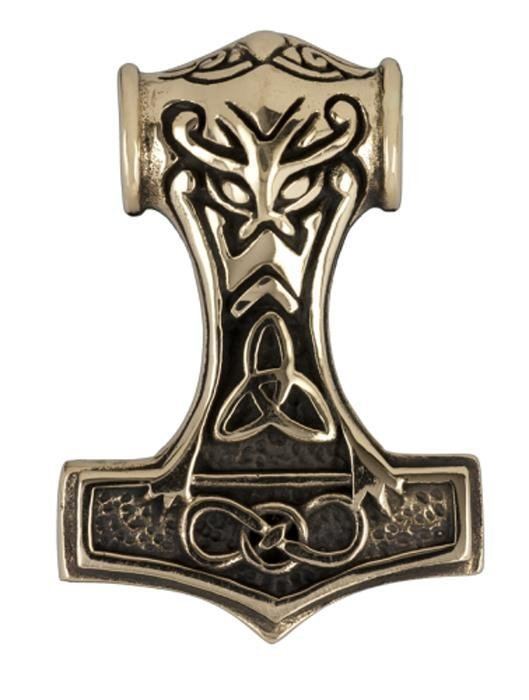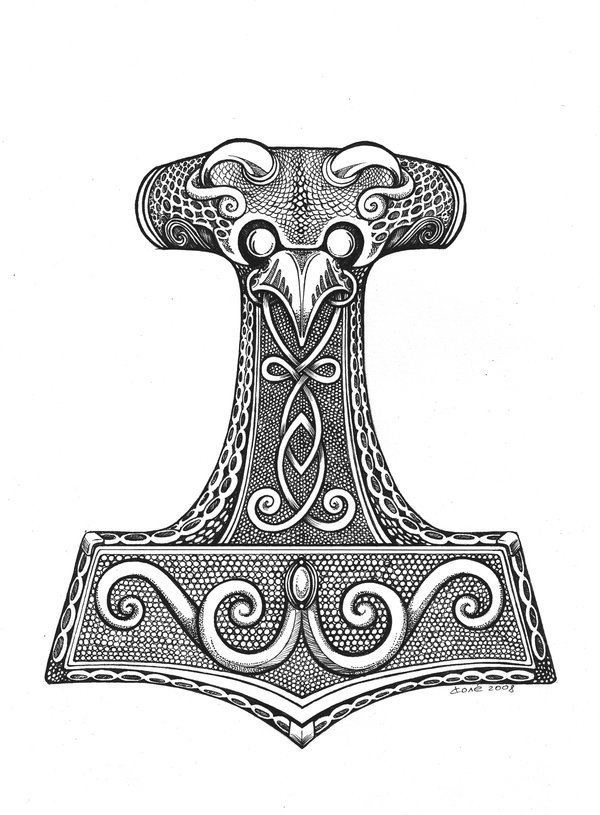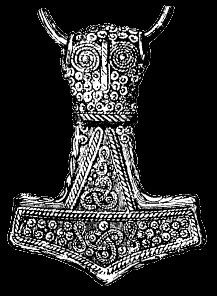 | ||
Mj lnir thor the dark world man at arms
In Norse mythology, Mjölnir (Old Norse: Mjǫllnir, [ˈmjɔlːnir]) is the hammer of Thor, a major Norse god associated with thunder. Mjölnir is depicted in Norse mythology as one of the most fearsome weapons, capable of leveling mountains. In his account of Norse mythology, Snorri Sturluson relates how the hammer was made by the dwarven brothers Sindri and Brokkr, and how its characteristically short handle was due to a mishap during its manufacture. Similar hammers (Ukonvasara) were a common symbol of the god of thunder in other North European mythologies.
Contents
- Mj lnir thor the dark world man at arms
- Planet coaster mj lnir
- Name
- Skldskaparml
- Poetic Edda
- Precedents and comparanda
- Viking Age pendants
- Viking Age depictions
- Swastika symbol
- Modern usage
- References

Planet coaster mj lnir
Name

Old Norse Mjǫllnir /ˈmjɔlːnir/ regularly becomes Mjøllnir /ˈmjœlːnir/ in Old Icelandic by the 13th century. The modern Icelandic form is Mjölnir, Norwegian and Danish Mjølner, Swedish Mjölner.

The name is derived from a Proto-Germanic form *meldunjaz, from the Germanic root of *malanan "to grind" (*melwan, Old Icelandic meldr, mjǫll, mjǫl "meal, flour"), yielding an interpretation of "the grinder; crusher".
Additionally, there is a suggestion that the mythological "thunder weapon" being named after the word for "grindstone" is of considerable, Proto-Indo-European (if not Indo-Hittite) age; according to this suggestion, the divine thunder weapon (identified with lightning) of the storm god was imagined as a grindstone (Russian molot and possibly Hittite malatt- "sledgehammer, bludgeon"), reflected in Russian молния (molniya) and Welsh mellt "lightning" (possibly cognate with Old Norse mjuln "fire").
In the Old Norse texts, Mjölnir is identified as hamarr "a hammer", a word that in Old Norse and some modern Norwegian dialects can mean "hammer" as well as "stone, rock, cliff", ultimately derived from an Indo-European word for "stone, stone tool", h₂éḱmō; as such it is cognate with Sanskrit aśman, meaning "stone, rock, stone tool; hammer" as well as "thunderbolt".
Skáldskaparmál
An account of the origin of Mjölnir is found in Skáldskaparmál from Snorri's Edda: In this story, Loki bets his head with Sindri (or Eitri) and his brother Brokkr that they could never succeed in making items more beautiful than those of the Sons of Ivaldi (the dwarves who created other precious items for the gods: Odin's spear Gungnir, and Freyr's foldable boat Skíðblaðnir).
Sindri and Brokkr accept Loki's bet and the two brothers begin working. They begin to work in their workshop and Sindri puts a pig's skin in the forge and tells his brother (Brokkr) never to stop working the bellows until he comes and takes out what he put in. Loki, in disguise as a fly, comes and bites Brokkr on the arm. Nevertheless, he continues to pump the bellows.
Then, Sindri takes out Gullinbursti, Freyr's boar with shining bristles. Next, Sindri puts some gold in the forge and gives Brokkr the same order. Again, Loki, still in the guise of a fly comes and, again, bites Brokkr's neck twice as hard as he had bitten his arm. Just as before, Brokkr continues to work the bellows despite the pain. When Sindri returns, he takes out Draupnir, Odin's ring, which drops eight duplicates of itself every ninth night.
Finally, Sindri puts some iron in the forge and tells Brokkr not to stop pumping the bellows. Loki comes a third time and this time bites Brokkr on the eyelid even harder. The bite is so deep that it draws blood. The blood runs into Brokkr's eyes and forces him stop working the bellows just long enough to wipe his eyes. This time, when Sindri returns, he takes Mjölnir out of the forge. The handle is shorter than Sindri had planned and so the hammer can only be wielded with one hand.
Despite the flaw in the handle, Sindri and Brokkr win the bet and go to take Loki's head. However, Loki worms his way out of the bet by pointing out that the dwarves would need to cut his neck to remove his head, but Loki's neck was not part of the deal. As a consolation prize, Brokkr sews Loki's mouth shut to teach him a lesson.
The final product is then presented to Thor, and its properties are described, as follows,
Then he gave the hammer to Thor, and said that Thor might smite as hard as he desired, whatsoever might be before him, and the hammer would not fail; and if he threw it at anything, it would never miss, and never fly so far as not to return to his hand; and if be desired, he might keep it in his sark, it was so small; but indeed it was a flaw in the hammer that the fore-haft was somewhat short. (Original: Þá gaf hann Þór hamarinn ok sagði, at hann myndi mega ljósta svá stórt sem hann vildi, hvat sem fyrir væri, at eigi myndi hamarrinn bila, ok ef hann yrpi honum til, þá myndi hann aldri missa ok aldri fljúga svá langt, at eigi myndi hann sækja heim hönd, ok ef þat vildi, þá var hann svá lítill, at hafa mátti serk sér. En þat var lýi á, ar forskeftit var heldr skammt.)
Poetic Edda
Thor possessed a formidable chariot, which is drawn by two goats, Tanngrisnir and Tanngnjóstr. A belt, Megingjörð, and iron gloves, Járngreipr, were used to lift Mjölnir. Mjölnir is the focal point of some of Thor's adventures.
This is clearly illustrated in a poem found in the Poetic Edda titled Þrymskviða. The myth relates that the giant, Þrymr, steals Mjölnir from Thor and then demands the goddess Freyja in exchange. Loki, the god notorious for his duplicity, conspires with the other Æsir to recover Mjölnir by disguising Thor as Freyja and presenting him as the "goddess" to Þrymr.
At a banquet Þrymr holds in honor of the impending union, Þrymr takes the bait. Unable to contain his passion for his new maiden with long, blond locks (and broad shoulders), as Þrymr approaches the bride by placing Mjölnir on "her" lap, Thor rips off his disguise and destroys Þrymr and his giant cohorts.
Precedents and comparanda
A precedent of these Viking Age Thor's hammer amulets are recorded for the migration period Alemanni, who took to wearing Roman "Hercules' Clubs" as symbols of Donar. A possible remnant of these Donar amulets was recorded in 1897, as a custom of Unterinn (South Tyrolian Alps) of incising a T-shape above front doors for protection against evils of all kinds, especially storms.
Viking Age pendants
About 50 specimens of Mjölnir amulets have been found widely dispersed throughout Scandinavia, dating from the 9th to 11th centuries, most commonly discovered in areas with a strong Christian influence including southern Norway, south-eastern Sweden, and Denmark. Due to the similarity of equal-armed, square crosses featuring figures of Christ on them at around the same time, the wearing of Thor's hammers as pendants may have come into fashion in defiance of the square amulets worn by newly converted Christians in the regions.
An iron Thor's hammer pendant excavated in Yorkshire, dating to ca. AD 1000 bears an uncial inscription preceded and followed by a cross, interpreted as indicating a Christian owner synchronising pagan and Christian symbolism.
A 10th-century soapstone mold found at Trendgården, Jutland, Denmark is notable for allowing the casting of both crucifix and Thor's hammer pendants. A silver specimen found near Fossi, Iceland (now in the National Museum of Iceland) can be interpreted as either a Christian cross or a Thor's hammer. Unusually, the elongated limb of the cross ends in a beast's (perhaps a wolf's) head.
The Købelev Runic-Thor’s Hammer, found at the Danish island of Lolland in 2014, is so far the only one bearing an inscription, proving that this kind of pendant is meant to be a hammer. The inscription reads "Hmar x is," which translates to "This is a hammer." However, the proper spelling is "hamar," indicating the creator was not a fully literate individual.
Viking Age depictions
Some image stones and runestones found in Denmark and southern Sweden bear an inscription of a hammer. Runestones depicting Thor's hammer include runestones U 1161 in Altuna, Sö 86 in Åby, Sö 111 in Stenkvista, Sö 140 in Jursta, Vg 113 in Lärkegapet, Öl 1 in Karlevi, DR 26 in Laeborg, DR 48 in Hanning, DR 120 in Spentrup, and DR 331 in Gårdstånga. Other runestones included an inscription calling for Thor to safeguard the stone. For example, the stone of Virring in Denmark had the inscription þur uiki þisi kuml, which translates into English as "May Thor hallow this memorial." There are several examples of a similar inscription, each one asking for Thor to "hallow" or protect the specific artifact. Such inscriptions may have been in response to the Christians, who would ask for God's protection over their dead.
Swastika symbol
According to some scholars, the swastika shape may have been a variant popular in Anglo-Saxon England prior to Christianization, especially in East Anglia and Kent. Wilson (1894) points out that while the swastika had been "vulgarly called in Scandinavia the hammer of Thor" ( in Icelandic: Thorshamarmerki, mark of Thor's hammer ), the symbol properly so called had a Y or T shape.
Modern usage
Most practitioners of Germanic Neopagan faiths wear Mjölnir pendants as a symbol of that faith worldwide. Renditions of Mjölnir are designed, crafted and sold by some Germanic Neopagan groups and individuals.
Some controversy has occurred concerning the potential recognition of the symbol as a religious symbol by the United States government. In May 2013 the "Hammer of Thor" was added to the list of United States Department of Veterans Affairs emblems for headstones and markers.
